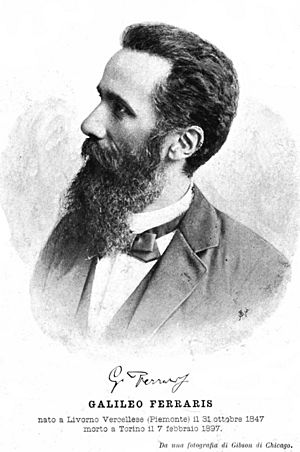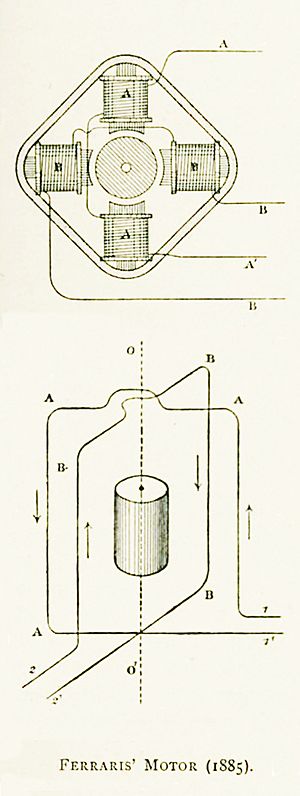Galileo Ferraris facts for kids
Quick facts for kids
Galileo Ferraris
|
|
|---|---|

Galileo Ferraris
|
|
| Born | 31 October 1847 Livorno Vercellese, Kingdom of Sardinia
|
| Died | February 7, 1897 (aged 49) |
| Nationality | Italian |
| Known for | Alternating current, Rotating magnetic field |
| Scientific career | |
| Fields | physics, engineering |
Galileo Ferraris (born October 31, 1847 – died February 7, 1897) was a smart Italian professor. He was a physicist and an electrical engineer. He helped create the AC power system we use today. He also invented the induction motor, which is a type of electric motor. Even though he didn't patent his inventions, many people thought his work was amazing. He wrote a detailed report about his experiments with transformers.
Contents
The Life and Discoveries of Galileo Ferraris
Galileo Ferraris was born in a place called Livorno Vercellese. This was in the Kingdom of Sardinia. He earned a master's degree in engineering. Later, he became a helper in technical physics at a museum.
In 1885, Ferraris started studying something important. He looked into the idea of a rotating magnetic field. This is a special kind of magnetic force that spins. He tried out many different types of electric motors. His studies led him to create an alternator. An alternator is a machine that turns mechanical power into electric power. It works like an AC motor in reverse.
How Ferraris Changed Electricity
On March 11, 1888, Ferraris shared his discoveries. He presented his research to the Royal Academy of Sciences in Turin. His alternators created systems of alternating currents. These currents were slightly out of sync with each other. They used the idea of a rotating magnetic field to work.
This new way of making power was called "polyphase power." It quickly became very popular. The invention of the polyphase alternator was a huge step for electricity. The power transformer was also very important. These inventions made it possible to send electricity over long distances. This could be done using wires and it was not too expensive.
Powering the World with Water
Polyphase power allowed people to use water power. Large dams could create hydroelectric power plants. These plants could be in faraway places. The energy from falling water was turned into electricity. This electricity could then power an electric motor anywhere. This meant machines could do work in many different locations. This new way of sending power helped power grids grow all over the world.
In 1889, Ferraris worked at the Italian Industrial Institution. This was a school for electrical engineering. It was the first school of its kind in Italy. Later, it became part of the Politecnico di Torino. In 1896, Ferraris joined the Italian Electrotechnical Association. He became the first president of this group.
Remembering Galileo Ferraris
The city of Turin wanted to honor Ferraris. He had given so much to science. A group suggested building a monument at the Royal Industrial Museum. This monument would remember his scientific and industrial achievements. Also, a street in Turin was named after him.
In January 2021, Ferraris was honored again. The IEEE Milestones program recognized his work. This program celebrates important steps in technology. Ferraris was honored for his "Rotating Fields and Early Induction Motors, 1885-1888." A special plaque was made for him. It says:
Galileo Ferraris, a professor in Turin, discovered the idea of the rotating magnetic field. Ferraris made his field using two coils that didn't move. These coils were powered by alternating currents that were out of sync. Ferraris also built early models of two-phase AC motors. Rotating fields, polyphase currents, and their use in induction motors were key to bringing electricity to the world.
See also
 In Spanish: Galileo Ferraris para niños
In Spanish: Galileo Ferraris para niños


